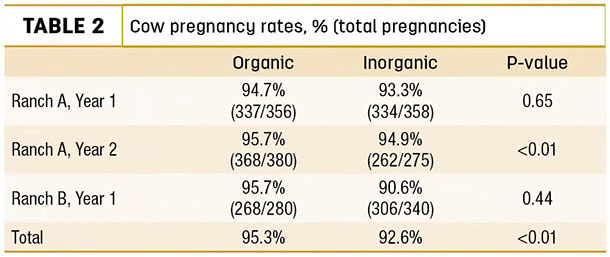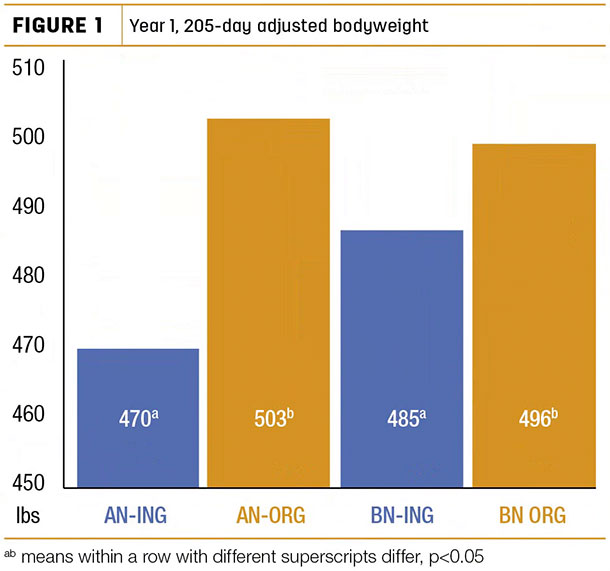Few research studies have examined the effects of prenatal and postnatal trace mineral supplementation on cow performance, reproduction and trace mineral status, and even fewer have researched the subsequent impacts on the growth, immunity and sexual development of calves born to supplemented cows.
That is, until now. Through a comprehensive, multi-year study on the prenatal and postnatal effects of differing trace mineral sources, the University of Florida recently released new research on the impacts of inorganic and organic trace mineral supplementation strategies.
Study overview
The University of Florida examined two different trace mineral strategies over two consecutive years in multiple feeding scenarios to test their impact on pregnancy rates, weaning weights and overall performance based on breed. Specifically, studies looked at supplementation with the trace elements cobalt, copper, manganese, zinc and selenium.
Inorganic trace mineral forms (ING) were sourced as salt sulfates and sodium selenite, while organic trace minerals (ORG) were received in the form of Bioplex and Sel-Plex (selenium).
The research was divided into two phases. Phase one examined pregnancy rates and weaning weights based on the trace mineral source supplemented on two adjacent, large cow herds (designated as Ranch A and Ranch B) over two years.
In total, 973 cows were allotted to the ING treatment, and 916 cows were allotted to the ORG treatment. In the first year, supplementation began approximately 90 days prior to calving and continued through weaning on both ranches.
In the second year, only Ranch A participated, and trace mineral supplementation occurred from conception through weaning. Ranch A utilized cows between 3 and 10 years old, while Ranch B used predominantly older, mature cows. Cow pregnancy rates were collected from both ranches in year one but only from Ranch A in year two. Calf weaning weights were collected from Ranch A for both years.

Phase two focused on the impact of ING and ORG on key production parameters by breed. In this phase, the University of Florida investigated the effects of prenatal and postnatal cow trace mineral supplement sources on cow and calf performance, calf immunity and sexual development in bulls and heifers born to trace mineral-supplemented dams.
Over two years, Angus and Brangus cows were supplemented with ING trace minerals in the form of sodium selenite and salt sulfates or ORG trace minerals in the form of Bioplex and Sel-Plex. Trace mineral supplements were started 90 days prior to calving and continued through weaning.
Over the multiple phases and years of this study, trace minerals had a positive impact on pregnancy, weaning weight and across breeds.
Pregnancy: A key driver of profitability
In phase one of the study, pregnancy rates were exceptionally good in both the ORG and ING treatments. There were no statistical differences between the trace mineral source for either ranch or in either year.

However, when evaluated over both years at both ranches, giving the study the statistical power to find small differences, ORG cows had a statistically significant (P equal to or less than 0.01) improvement in pregnancy rates (95.3 percent, 873 of 916 cows) compared to ING cows (92.6 percent, 901 of 973 cows), a 2.7 percent improvement for ORG.
Some may scoff at a 2.7 percent improvement in cow herd pregnancy rates, but even with pregnancy rates already over 90 percent, a simple change to ORG mineral sources improved them further. Calculating a value of pregnancy and return on investment, while not common to many cow herds, can be done.
For example, assume a 100-cow herd, using the actual pregnancy rates from the experiment. With an estimated weaning rate of 97 percent of pregnancies, actual weaning weights from the experiment, estimated calf prices with weight slides and actual mineral costs, the use of ORG would result in 2.6 more calves.
These extra calves would generate additional revenue of $1,471 and a net return of $945, resulting in a return on investment of 2.8 to 1 on every additional dollar spent for the use of organic trace minerals.
Trace minerals and ROI on weaning weights
In phase one, weaning weight data was gathered by ranch and by sex. At the two ranches tested, Ranch A and Ranch B, there was a statistically significant mineral source effect on weaning weights collected from Ranch A. Calves from cows supplemented with ORG weaned at an average calf weight of 548 pounds, compared to 523 pounds for calves from cows supplemented with ING. This was an average improvement of 25 pounds of weaning weight in the ORG treatment.
By sex, the majority of this improvement came in heifers from the ORG treatment. On average, they weighed 31 pounds more than heifers from the ING treatment, a statistically significant difference. The difference between mineral sources for steer weaning weight was not statistically significant, but ORG mineral steers were, on average, 18 pounds heavier than their ING counterparts.
Regardless, using the same price slide as the pregnancy data, the ORG trace mineral value of gain at weaning was $0.88, resulting in a 4.1-to-1 return on investment for every dollar spent on ORG trace minerals.
Angus or Brangus: Impacts of trace mineral source
Phase two of the study, recently published in The Professional Animal Scientist, researched the impact of ORG and ING trace mineral sources across Angus and Brangus breeds. The study looked at colostrum and weaning weights over a two-year period and showed a few key differences.
At calving, colostrum from ORG Angus and Brangus cows had greater selenium levels and tended to have greater immunoglobulin M concentrations than colostrum from ING cows. ORG Angus and Brangus calves also had greater serum immunoglobulin A at 12 hours and 24 hours, and greater immunoglobulin G 30 days after colostrum consumption than did ING calves.
Birthweight and 60-day pregnancy rates did not differ by trace mineral source over the two years of the study. However, in year one, Angus calves weaned from ORG trace mineral-supplemented cows did have a statistically significant increase (33 pounds) in adjusted 205-day weaning weights compared to Angus ING cows.
 Comparatively, Brangus calves also demonstrated an 11-pound increase in weaning weights compared to ING. Yet, by breed, neither Brangus nor Angus were statistically different from one another. In year two, the results remained consistent across both breeds, with an average 12-pound increase in 205-day weaning weight supporting ORG calves.
Comparatively, Brangus calves also demonstrated an 11-pound increase in weaning weights compared to ING. Yet, by breed, neither Brangus nor Angus were statistically different from one another. In year two, the results remained consistent across both breeds, with an average 12-pound increase in 205-day weaning weight supporting ORG calves.
So what is the bottom line for trace mineral sources from these studies? Small changes in trace mineral supplementation can have a dramatic effect on the metabolic pathways that affect the health, reproduction and profitability of cattle.
Economic decisions should focus less on price per bag or even price per ton of mineral. The true and appropriate outcomes of cow pregnancies, weaned calves and calf weaning weights, are production endpoints of interest and importance. An outcome-based decision encompasses more than just the cash outlay, considering the return the investment brings about.
In summary, this new research supports organic trace minerals leading to more positive cow and calf performance. ![]()
Matt Hersom is a beef cattle specialist with the University of Florida. Email Matt Hersom.








